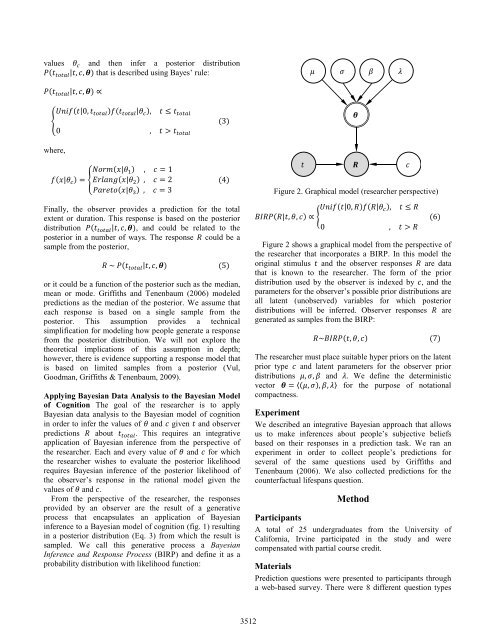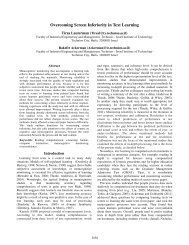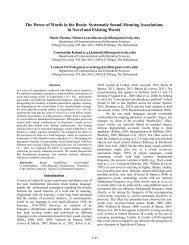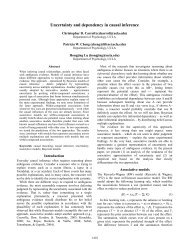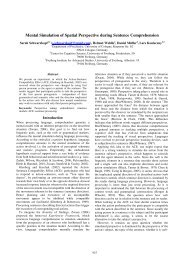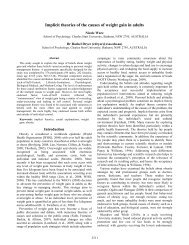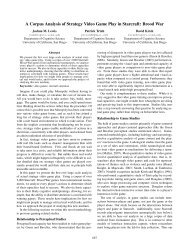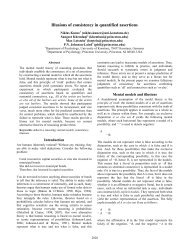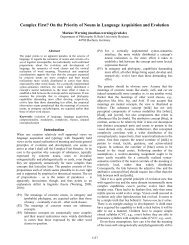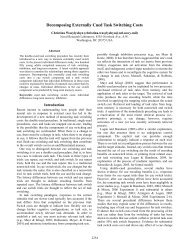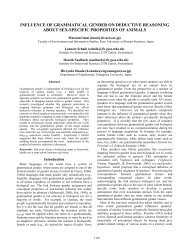Inferring Subjective Prior Knowledge: An ... - MindModeling.org
Inferring Subjective Prior Knowledge: An ... - MindModeling.org
Inferring Subjective Prior Knowledge: An ... - MindModeling.org
You also want an ePaper? Increase the reach of your titles
YUMPU automatically turns print PDFs into web optimized ePapers that Google loves.
values and then infer a posterior distribution<br />
( | ) that is described using Bayes’ rule:<br />
( | )<br />
{<br />
( | ) ( | )<br />
(3)<br />
where,<br />
( | ) {<br />
( | )<br />
( | )<br />
( | )<br />
(4)<br />
Finally, the observer provides a prediction for the total<br />
extent or duration. This response is based on the posterior<br />
distribution ( | ), and could be related to the<br />
posterior in a number of ways. The response could be a<br />
sample from the posterior,<br />
( | ) (5)<br />
or it could be a function of the posterior such as the median,<br />
mean or mode. Griffiths and Tenenbaum (2006) modeled<br />
predictions as the median of the posterior. We assume that<br />
each response is based on a single sample from the<br />
posterior. This assumption provides a technical<br />
simplification for modeling how people generate a response<br />
from the posterior distribution. We will not explore the<br />
theoretical implications of this assumption in depth;<br />
however, there is evidence supporting a response model that<br />
is based on limited samples from a posterior (Vul,<br />
Goodman, Griffiths & Tenenbaum, 2009).<br />
Applying Bayesian Data <strong>An</strong>alysis to the Bayesian Model<br />
of Cognition The goal of the researcher is to apply<br />
Bayesian data analysis to the Bayesian model of cognition<br />
in order to infer the values of and given and observer<br />
predictions about . This requires an integrative<br />
application of Bayesian inference from the perspective of<br />
the researcher. Each and every value of and for which<br />
the researcher wishes to evaluate the posterior likelihood<br />
requires Bayesian inference of the posterior likelihood of<br />
the observer’s response in the rational model given the<br />
values of and .<br />
From the perspective of the researcher, the responses<br />
provided by an observer are the result of a generative<br />
process that encapsulates an application of Bayesian<br />
inference to a Bayesian model of cognition (fig. 1) resulting<br />
in a posterior distribution (Eq. 3) from which the result is<br />
sampled. We call this generative process a Bayesian<br />
Inference and Response Process (BIRP) and define it as a<br />
probability distribution with likelihood function:<br />
Figure 2. Graphical model (researcher perspective)<br />
( | ) {<br />
( | ) ( | )<br />
(6)<br />
Figure 2 shows a graphical model from the perspective of<br />
the researcher that incorporates a BIRP. In this model the<br />
original stimulus and the observer responses are data<br />
that is known to the researcher. The form of the prior<br />
distribution used by the observer is indexed by , and the<br />
parameters for the observer’s possible prior distributions are<br />
all latent (unobserved) variables for which posterior<br />
distributions will be inferred. Observer responses are<br />
generated as samples from the BIRP:<br />
( ) (7)<br />
The researcher must place suitable hyper priors on the latent<br />
prior type and latent parameters for the observer prior<br />
distributions and . We define the deterministic<br />
vector 〈( ) 〉 for the purpose of notational<br />
compactness.<br />
Experiment<br />
We described an integrative Bayesian approach that allows<br />
us to make inferences about people’s subjective beliefs<br />
based on their responses in a prediction task. We ran an<br />
experiment in order to collect people’s predictions for<br />
several of the same questions used by Griffiths and<br />
Tenenbaum (2006). We also collected predictions for the<br />
counterfactual lifespans question.<br />
Method<br />
Participants<br />
A total of 25 undergraduates from the University of<br />
California, Irvine participated in the study and were<br />
compensated with partial course credit.<br />
Materials<br />
Prediction questions were presented to participants through<br />
a web-based survey. There were 8 different question types<br />
3512


